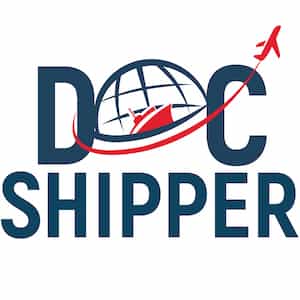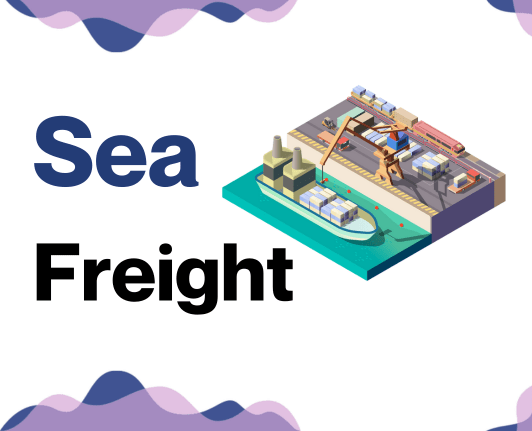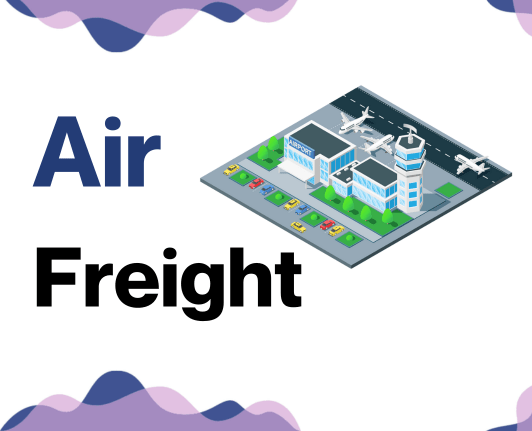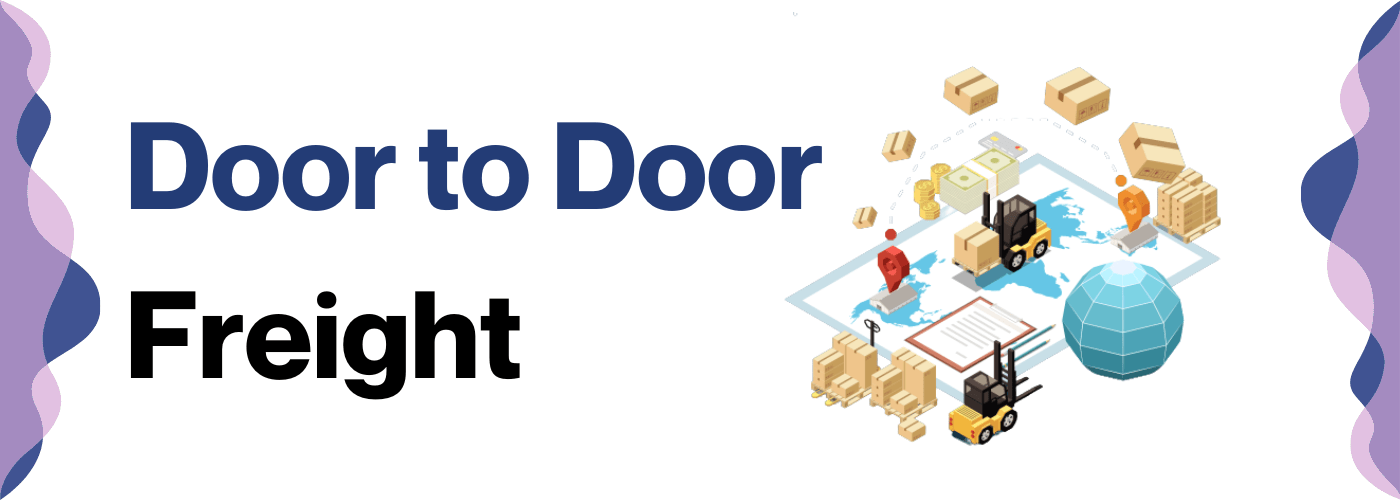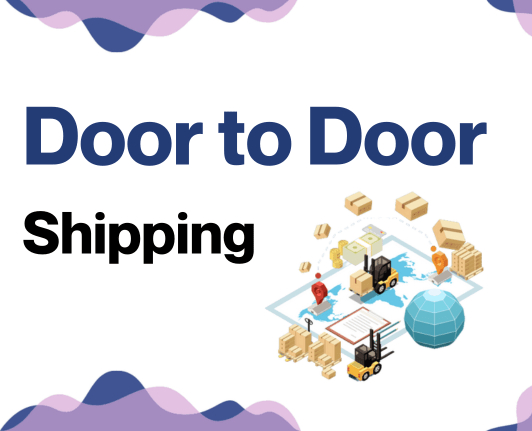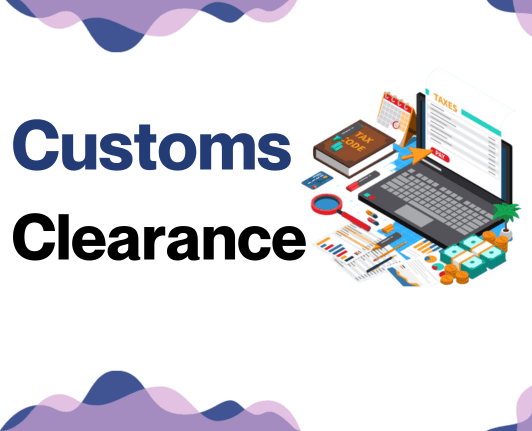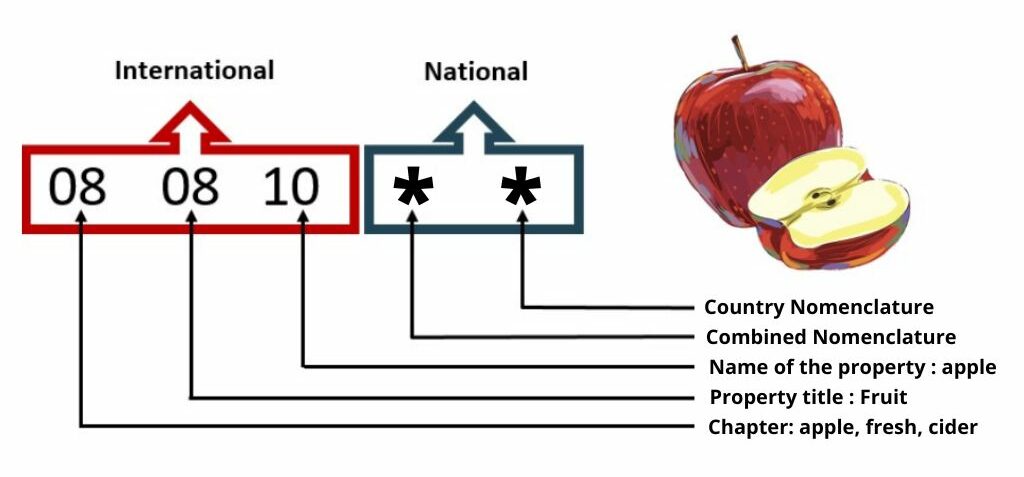Did you know that 'Suomi' is actually how you say 'Finland' in Finnish? Certainly easier than pronouncing some Malaysian street names! Jokes aside, the intricate processes of understanding rates, analyzing transit times, and navigating (figuratively) through customs regulations can feel a bit like learning a new language.
This guide provides comprehensive information on these areas, leading you confidently through the route between Malaysia and Finland. It details freight options spanning air, sea, road, and rail, examines the customs clearance process, untangles the web of duties and taxes, and provides business-oriented advice tailored to your specific needs.
If the process still feels overwhelming, let DocShipper handle it for you! With their efficient, full-service approach, they make international shipping simpler for businesses, turning the challenges of transport into success stories every single day.
Table of Contents
Which are the different modes of transportation between Malaysia and Finland?
Traveling from the steamy equator to the frosty north, shipping goods between Malaysia and Finland can feel like a board game played on a world map. The vast distance, coupled with multiple international borders, immediately rules out road transport. So, think of it this way: Do you take the slower, scenic train (ocean freight) or the pricier, swift plane (air freight)? Each has its virtues and choosing wisely depends on your cargo's nature, urgency, and budget constraints. Let's gear up and explore these strategic moves, tailored specifically to shipping between our tropical Southeast Asian start and snowy Scandinavian finish lines.
How can DocShipper help?
Looking to ship goods between Malaysia and Finland? The process can feel like a maze, but with DocShipper, it's a smooth sail. Our expert team handles everything from organizing transport to customs clearance. Got doubts? Don't hesitate! Dial up our consultants for quick, cost-free advice or reach out for a free estimate delivered in under 24 hours!
DocShipper Tip: Sea freight might be the best solution for you if:
- You're dealing with hefty quantities or oversized goods. Sea transport is your go-to for maximizing space without stretching your budget.
- Time sensitivity isn't a concern for your shipment. Ocean freight is known for its leisurely pace, especially when compared to the speed of air or rail.
- Your supply chain connects key international harbors. This positions you to take full advantage of a wide-reaching network of ocean trade routes.
Sea freight between Malaysia and Finland
Malaysia and Finland share a vibrant trade relationship, with bustling sea lanes it's lifeblood. Picture major ports like Port Klang on the Strait of Malacca and Kotka on the Gulf of Finland as the beating hearts of their respective industries, circulatory systems pumping goods across the globe. Ocean shipping between these two is a cost-effective lifeline, ideal for handling high-volume goods. However, it's not a sprint—it's a marathon, with transit times longer than air or road transport.
For many businesses, the crossing can seem like an insurmountable mountain. Whether you're a seasoned shipper or a novice exporter, the complexities of international freight procedures can often lead to costly errors. But fear not, we're here to chart out your climb, highlighting the steps towards effortless shipping. Our guide delves into the best practices and specifications that make the journey smoother, so you can sail through with confidence and efficiency. Because even Everest is doable with the right equipment!
Main shipping ports in Malaysia
Port Klang
Location and Volume: Located close to the Malaysian capital of Kuala Lumpur, Port Klang is a central cog in the region's trade machine and handles roughly 13.5 million TEU. It is prime among the international ports of Malaysia.
Key Trading Partners and Strategic Importance: With China, Singapore, Indonesia, and the USA as its primary trading partners, Port Klang is a major hub for goods headed to Southeast Asia. Its importance is also underscored by the fact it's the world's 12th busiest port.
Context for Businesses: If you're looking to expand into Southeast Asia or leverage strategic trade relationships with these countries, Port Klang is a prime receiver and sender of goods, due to its vast connectivity and proximity to Kuala Lumpur.
Johor Port
Location and Volume: Situated in Pasir Gudang, Johor, it provides substantial trade resources with an annual shipping volume of approximately 1 million TEU. This port is another significant maritime gateway in Malaysia.
Key Trading Partners and Strategic Importance: Predominantly, Johor Port handles trade with neighbors Indonesia and Thailand, as well as China and Australia. Its strategic location straddling the busiest shipping route in the world — the Straits of Malacca — allows for unfettered access to the global supply chain.
Context for Businesses: Expanding your reach into the Australasian markets? Johor Port is a tantalizing choice given its trade partnerships and strategic location.
Port of Tanjung Pelepas
Location and Volume: Located in the southern tip of the Malaysian peninsula, Tanjung Pelepas has an annual shipping volume going up to 12.5 million TEU. It is quickly becoming a critical player among Malaysia's ports.
Key Trading Partners and Strategic Importance: The key trading partners include China, USA, Europe, and South Asia. It's becoming especially noteworthy as the second largest port in Malaysia and the 18th busiest in the world.
Context for Businesses: If your shipping needs focus on engaging with a variety of markets, from the US to South Asia, the fast developing Port of Tanjung Pelepas should be on your radar.
Main shipping ports in Finland
Port of Helsinki
Location and Volume: Positioned in southern Finland on the Gulf of Finland, the Port of Helsinki is crucial for European trade, boasting a whopping volume of around 14.7 million tonnes per year.
Key Trading Partners and Strategic Importance: The port primarily trades with Germany, Russia, Sweden, and Estonia. It's strategically significant due to its location, providing the shortest maritime connection between Asia and Europe via the Northern Sea Route.
Context for Businesses: If you're looking to cement your foothold in the European market, incorporating the Port of Helsinki into your logistics might be advantageous, thanks to its high volume capacity and efficiency.
Port of HaminaKotka
Location and Volume: The Port of HaminaKotka, located towards the east of Finland near the Russian border, manages a volume of 17 million tonnes annually, making it the largest universal, export, and transshipment port in Finland.
Key Trading Partners and Strategic Importance: Key trading partners include Russia, the USA, the Netherlands, Japan, and Germany. Embodying strategic importance, the port is part of the Scandinavian-Mediterranean Corridor, facilitating smooth trade operations in the Euro-Asian region.
Context for Businesses: If your business strategy involves extensive trade with Russia or transshipping via Scandinavia, the Port of HaminaKotka could provide operational advantages due to its strategic location and diverse services.
Port of Vuosaari
Location and Volume: The Port of Vuosaari, situated on the outskirts of Helsinki, handles over 12.5 million tonnes each year, earmarking it as the leading container port in Finland.
Key Trading Partners and Strategic Importance: Its principal trading partners include Germany, Russia, the UK, and the Netherlands. As Finland’s most modern cargo port and part of the strategic Trans-European Network, Vuosaari is crucial to maintaining efficient maritime trade.
Context for Businesses: Should your business operations require a modern, efficient container port with extensive connections, consider utilizing the Port of Vuosaari's capabilities in your logistics plan.
Port of Turku
Location and Volume: Located in southwestern Finland, the Port of Turku processes about 4 million tonnes per annum, serving as an essential route to Sweden and the rest of Scandinavia.
Key Trading Partners and Strategic Importance: Sweden is the primary trading partner. As a part of the Scandinavian-Mediterranean Corridor, the port’s role in Finland's foreign trade is immense.
Context for Businesses: For businesses aiming to expand operations in Sweden or other Scandinavian countries, incorporating the Port of Turku into your logistics could offer convenient and frequent connections.
Port of Oulu
Location and Volume: The Port of Oulu, situated in the Gulf of Bothnia, handles about 3.6 million tonnes a year, marking it as the leading export port in northern Finland.
Key Trading Partners and Strategic Importance: The port mainly trades with Germany, Sweden, the UK, and Russia. As the northernmost year-round port in the EU, it plays a strategic role in facilitating trade with Canada via the Arctic Ocean.
Context for Businesses: If your aim is to penetrate markets in northern Europe or Arctic areas, leveraging the Port of Oulu's unique location can potentially boost your strategic advantage.
Should I choose FCL or LCL when shipping between Malaysia and Finland?
Choosing whether to ship your goods from Malaysia to Finland using Full Container Load (FCL) or Less than Container Load (LCL), also known as consolidation, can be just as strategic as picking your route. It's a decision that will influence the cost, delivery time, and even the safety of your goods. But fret not, this section will help unpack these options, so you can make a decision that's right for your specific shipping requirements. It's not just about moving boxes, after all, it's about smartly navigating the high seas of international shipping.
LCL: Less than Container Load
Definition: Less Than Container Load (LCL) shipping is a method where multiple consignments from different shippers are consolidated into one container for transportation. It suits smaller shipment sizes and offers greater flexibility and cost advantages.
When to Use: LCL is a smart move when your cargo occupies less than about 15 CBM. It gives you the liberty to ship smaller quantities without waiting to fill a whole container, making your logistics more adaptable to your needs.
Example: Imagine you run a business in Finland, importing exotic wooden crafts from Malaysia. Instead of waiting to accumulate enough crafts to fill a full container, which might take weeks or even months, using LCL, you can successfully ship your smaller volumes of goods in a shared container, ensuring a steady stream of inventory without any delays.
Cost Implications: LCL freight costs are typically calculated per CBM, meaning you pay only for the space your goods occupy within the container rather than a flat fee for the entire space. This could lead to substantial cost savings, especially if your cargo volume is low. However, there may be higher handling fees due to the consolidation of multiple shipments.
FCL: Full Container Load
Definition: FCL, or Full Container Load, refers to shipping a large volume of goods where you have exclusive use, and thus control, over a whole container. Whether it's a 20'ft or 40'ft container, it presents an efficient choice in terms of cost, safety, and convenience.
When to Use: Typically, FCL shipping is your best bet when your cargo exceeds 13/14/15 Cubic Meters (CBM). Since the container is sealed at the origin and remains unopened until it reaches the destination, the risk of damage, theft, or misplacement substantially reduces, ensuring maximum safety for your cargo.
Example: Let's take electronic components manufacturer ABC Ltd. As they export their products from Malaysia to Finland, they consistently fill a 20’ft container. Opting for FCL shipping allows them to seal their high-volume shipment at their own facility, minimizing risks along the way.
Cost Implications: While FCL's initial cost may be higher than Less than Container Load (LCL), when calculated per CBM, it becomes significantly more cost-effective for high-volume shipping. Moreover, an FCL shipping quote is more predictable and less variable than LCL, enhancing cost control for businesses.
Unlock hassle-free shipping
Make shipping between Malaysia and Finland easy with DocShipper's expert freight forwarder services. Our ocean freight professionals analyze factors like cost-effectiveness, shipping volume, and urgency to recommend consolidated or full container shipping. Don't let logistics stress you out - we're here to simplify the process. Take a step forward and request a free estimation today. Sail smoothly into seamless shipping with DocShipper.
How long does sea freight take between Malaysia and Finland?
Sea freight between Malaysia and Finland usually takes between 35 to 45 days on average. This estimation of transit time takes into account certain elements like the specific ports utilized, the weight of the shipment, and the nature of the goods. For more personalized shipping requirements and accurate quotes, reaching out to a freight forwarder like DocShipper is advisable.
Average Transit Times in Days for Sea Freight:
| Malaysia (Port) | Finland (Port) | Transit Time (Days) |
| Port Klang | Port of Helsinki | 39 |
| Port of Tanjung Pelepas | Port of Kotka | 38 |
| Port of Penang | Port of Rauma | 33 |
| Port of Johor | Port of Turku | 35 |
*These are estimations and actual transit times may vary.
How much does it cost to ship a container between Malaysia and Finland?
Ocean freight rates between Malaysia and Finland can range substantially based on a myriad of factors making it difficult to state an exact shipping cost per CBM. Variables including Point of Loading, Point of Destination, the specific carrier, nature of your goods, as well as monthly market fluctuations all contribute to the final quotation.
We understand this may feel overwhelming, but rest assured, our adept shipping specialists are at your disposal. We'll assess your unique circumstances and provide a bespoke quote that suits you, ensuring every decision increases the cost-efficiency and safety of your transportation cargo. With us, getting the best shipping rates becomes less of a hurdle and more a seamless part of your international trade journey.
Special transportation services
Out of Gauge (OOG) Container
Definition: An OOG container is a special type of transport solution designed to carry oversized goods that exceed standard container dimensions.
Suitable for: Items that are out of gauge cargo, that is too wide, tall, or long for conventional containers.
Examples: Examples of OOG cargo include large machinery parts, industrial equipment, construction units.
Why it might be the best choice for you: If your business needs to ship larger items from Malaysia to Finland that do not fit into conventional container dimensions, the OOG container is your most suitable option.
Break Bulk
Definition: Break bulk is a shipping method where goods are loaded individually and not in containers.
Suitable for: This method is ideal for loose cargo load with irregular shapes or sizes.
Examples: Examples of break bulk items include wood, paper, or machinery that require special handling during loading and unloading.
Why it might be the best choice for you: If your goods can't fit in standard sized containers or require special handling, break bulk is the perfect solution for you.
Dry Bulk
Definition: Dry bulk refers to the transport of dry materials, usually granular or in bulk.
Suitable for: Products such as coal, iron ore, or grains, that can be loaded directly into the ship's hold.
Examples: A good example of dry bulk goods is grains exported from Malaysia to Finland.
Why it might be the best choice for you: If you're transporting large quantities of granular products, Dry bulk can be the most efficient and cost-effective option.
Roll-on/Roll-off (Ro-Ro)
Definition: Roll-on/Roll-off shipping, often abbreviated as Ro-Ro, involves vehicles being driven onto a ro-ro vessel and secured within the ship.
Suitable for: Ro-Ro shipping is ideal for self-propelled, wheeled or tracked vehicles such as cars, trucks or construction machinery.
Examples: An example could be the shipment of cars or tractors from Malaysia to Finland.
Why it might be the best choice for you: If your goods are large, self-propelled machinery or vehicles, Ro-Ro offers a simple and cost-effective solution.
Reefer Containers
Definition: Reefer containers are refrigerated containers used specifically for the transportation of temperature-sensitive goods.
Suitable for: Perishables like fruits, vegetables, meat, and other goods that require controlled temperatures.
Examples: You may use reefer containers to export fresh seafood from Malaysia to Finland.
Why it might be the best choice for you: If you are in the business of perishables and need to ensure that your goods remain fresh throughout the journey, then reefer containers are your best bet.
Whatever your shipping needs might be, DocShipper is here to help. We invite you to get in touch with us for a free shipping quote in less than 24 hours. Discover how easy and efficient shipping from Malaysia to Finland can be with DocShipper.
DocShipper Tip: Air freight might be the best solution for you if:
- You're pressed for time or facing a non-negotiable deadline. Air freight delivers unparalleled speed when it comes to transit times.
- Your shipment is modest in size, falling under 2 CBM. Air freight is particularly well-suited for these smaller consignments.
- Your supply chain includes destinations that are off the beaten maritime or rail paths. Air freight gives you access to a comprehensive global airport network.
Air freight between Malaysia and Finland
When you're rushing to send precious handcrafted jewelry from Kuala Lumpur to Helsinki, you'll want a speedy, safe, and reliable shipping method. That's where air freight is your go-to champion! Costly for large consignments, yes, but surprisingly efficient for smaller, high-value treasures like your jewelry. Imagine a flock of birds taking flight - that's how seamless and swift the journey is! You send, they fly, your customers smile.
But pause, before you head straight for the runway! There are common pitfalls some businesses tumble into. Picture gauging the price of your parcel by its weight alone - it’s like guessing the size of an iceberg by its tip! Then imagine solely relying on standard shipping practices, like only following the usual flight route - and missing out on tailored, cost-saving strategies. Whether estimating the merchandise price correctly, or digging deeper into best practices around shipping costs, be sure to consider all the angles. Why? To keep your shipment smooth and your wallet happy! Stay tuned, we will explore these potential mistakes and much more.
Air Cargo vs Express Air Freight: How should I ship?
Transporting merchandise from Malaysia to Finland, and can't decide between air cargo and express air freight? It's a common dilemma in the logistics world! Let's simplify; air cargo involves sharing space in a regular airline plane, whereas express air freight services reserve an entire plane for your goods only. Stick with us to weigh the options for your business needs.
Should I choose Air Cargo between Malaysia and Finland?
Opting for air cargo between Malaysia and Finland can be cost-effective and reliable. Prominent airlines, like Malaysia Airlines and Finnair, cater to these routes, ensuring timely transportation and efficient service. While longer transit times could be expected due to pre-determined schedules, the efficiency and service quality often outweigh this factor. Furthermore, if you're dealing with cargo above 100/150kg (220/330 lbs), airline cargo becomes an increasingly attractive option. The choice ultimately depends on your budgetary and transportation needs.
Should I choose Express Air Freight between Malaysia and Finland?
Express air freight, as the name suggests, provides rapid delivery using special cargo planes without passengers. If your shipment to Finland from Malaysia is under 1 CBM or weighs between 100-150 kg (220-330 lbs), this could be your best option for a fast, hassle-free delivery. The service is provided through reliable international courier firms like FedEx, UPS, or DHL. These firms ensure your goods' speedy and safe transit, which especially aids businesses dealing in perishable items or time-sensitive goods. Opting express air freight truly ensures you're keeping pace with your business demands.
Main international airports in Malaysia
Kuala Lumpur International Airport
Cargo Volume: KL handles over 1.8 million metric tonnes of cargo yearly, making it a gateway for international importers and exporters.
Key Trading Partners: The airport frequently transacts with China, USA, Singapore, Japan, and Australia.
Strategic Importance: KLIA's advantage is its strategic location on the Asia-Pacific trade route. It's a major connecting hub for worldwide cargo.
Notable Features: KLIA has a Free Commercial Zone (FCZ), and its Advanced Cargo Centre is the largest in the region.
For Your Business: Given its high cargo volume and extensive global connection, KLIA can provide your business with numerous direct flights and wide-ranging network, reducing transit times for your goods.
Penang International Airport
Cargo Volume: The airport handles around 360,000 metric tonnes of cargo annually.
Key Trading Partners: Its main trading partners are China, USA, Hong Kong, India, and Taiwan.
Strategic Importance: The airport is a leading logistics hub due to its robust links to trade corridors and its strong electronics and manufacturing industries.
Notable Features: The airport is particularly strong in trans-shipping electronic products and parts.
For Your Business: If your company specializes in electronics, leveraging Penang International Airport could facilitate quick and efficient transport of your goods.
Sultan Abdul Aziz Shah Airport
Cargo Volume: It handles approximately 60,000 metric tonnes of cargo per annum.
Key Trading Partners: The airport primarily deals with Asian countries like Japan, China, and Thailand.
Strategic Importance: The airport's extensive regional network, makes it an important intra-Asia trade hub.
Notable Features: Notably, it offers both scheduled and chartered cargo flights, offering flexibility for businesses.
For Your Business: If your business requires frequent cargo flights within the Asian continent, Sultan Abdul Aziz Shah Airport’s regional network might be beneficial for your operations.
Sultan Ahmad Shah Airport
Cargo Volume: The airport manages yearly approximations of 1,000 metric tonnes of cargo.
Key Trading Partners: Its main trading partners are within the ASEAN countries.
Strategic Importance: Its strategic position in the east coast of Peninsular Malaysia makes it significant for regional trade.
Notable Features: Its shorter lead times from Asian manufacturing hubs can be beneficial for businesses with time-sensitive freight.
For Your Business: If your company has strong trade relations with ASEAN countries, you may find Sultan Ahmad Shah Airport an efficient option for your cargo shipping.
Bintulu Airport
Cargo Volume: It processes nearly 2,100 metric tonnes of cargo per year.
Key Trading Partners: The airport has strong links with Indonesia, Australia, and within Malaysia.
Strategic Importance: Bintulu Airport is in the heart of Malaysia's gas and timber industry, and it's a significant link for Sarawak's industry to the global market.
Notable Features: The airport specializes in transporting timber and oil and gas equipment, making it unique among Malaysian airports.
For Your Business: If your business deals with timber or oil and gas equipment, Bintulu Airport could be a strategic choice for your cargo shipping needs.
Main international airports in Finland
Helsinki Airport
Cargo Volume: Helsinki Airport has a high cargo turnover, handling well over 200,000 metric tons of cargo in recent years.
Key Trading Partners: As Finland's major international airport, it engages in trade with countries all over the world, including Germany, Sweden, Russia, and China.
Strategic Importance: Located just north of Helsinki, the airport is a central hub for European, and particularly Nordic, international cargo traffic. Its strategic location allows for speedy deliveries to both Eastern and Western Europe.
Notable Features: Offering temperature-controlled facilities for sensitive cargo, such as pharmaceuticals, and utilizing the latest technology for automated cargo handling, Helsinki Airport stands out due to its efficiency and versatility.
For Your Business: If your business frequently ships to or from European countries, Helsinki Airport's prime location, large cargo capacity, and state-of-the-art facilities could help streamline your logistics processes.
Tampere-Pirkkala Airport
Cargo Volume: This airport handles a smaller cargo volume than Helsinki, but it's rapidly growing with tens of thousands of tons each year.
Key Trading Partners: Predominantly caters to European countries, with the likes of Germany, the UK, and Poland being key partners.
Strategic Importance: Situated near Tampere, the second-largest city in the country, Tampere-Pirkkala Airport plays a significant role in domestic cargo movement and offers an alternative route for international shipments.
Notable Features: Key features include its capability to handle a range of cargo types, from agricultural produce to machinery, and its efficient cargo handling procedures.
For Your Business: If you seek diversity in your shipping strategies or if your key markets are in and around Tampere, considering Tampere-Pirkkala for your cargo needs could be beneficial.
Turku Airport
Cargo Volume: Turku Airport closely follows Tampere-Pirkkala in terms of cargo volume, handling tens of thousands of tonnes annually.
Key Trading Partners: Maintains strong trade connections with other European countries such as Sweden, Belgium, and Russia.
Strategic Importance: Located on the southwest coast of Finland, Turku Airport provides quick access to the Baltic Sea region, making it a well-positioned logistics hub.
Notable Features: Turku features 24/7 operations, a dedicated freight terminal, and direct motorway access to the harbor.
For Your Business: Turku Airport's unrestricted operating hours and convenient motorway access might be particularly beneficial if your business involves bulky or heavy goods, or if time-sensitive shipping is a consistent requirement.
Oulu Airport
Cargo Volume: Handling thousands of tons of cargo annually, Oulu Airport is a smaller but crucial regional cargo hub.
Key Trading Partners: Caters widely to Scandinavian countries, whilst maintaining strong connections with the rest of Europe.
Strategic Importance: Oulu Airport's northern location plays a pivotal role in connecting the Nordic region's cargo circulation with the rest of the world.
Notable Features: Oulu Airport is especially well-equipped to handle special cargo, such as temperature-sensitive goods, thanks to its modern facilities.
For Your Business: If you require a regional hub that can facilitate Nordic-EU connections or if your cargo needs special handling, Oulu Airport might be a suitable option.
Rovaniemi Airport
Cargo Volume: Rovaniemi Airport's cargo volume is less than Oulu's, but it is steadily increasing, indicating a thriving cargo industry.
Key Trading Partners: While this airport's trading partners are mainly within Europe, it also has thriving trade relations with Asia, especially China.
Strategic Importance: Rovaniemi Airport sits in the heart of Lapland, serving as the gateway to the Arctic region and providing connection routes for East-West air cargo traffic.
Notable Features: Well-equipped to handle all types of cargo, and specifically recognized for accommodating charter flights during the peak Christmas season.
For Your Business: Rovaniemi's unique position offers both seasonal business opportunities and efficient connections to burgeoning Asian markets. If your enterprise navigates these waters, this Airport may fit within your logistics plans.
How long does air freight take between Malaysia and Finland?
The estimated air freight transit time from Malaysia to Finland typically falls between 8-10 days. However, these durations can fluctuate depending on specific factors such as the departure and arrival airports, the weight of your cargo, and the type of goods being transported. Precision becomes crucial in managing your shipping timeline, hence it's advisable to seek exact timings from a competent freight forwarder like DocShipper.
How much does it cost to ship a parcel between Malaysia and Finland with air freight?
Air freight rates between Malaysia and Finland can broadly range from $3 to $10 per kg, but the exact figures are subjective to various factors such as airport distance, parcel dimensions, weight, and nature of goods. While we cannot offer instant pricing, our dedicated team will gladly assist you to get the best possible rates, quoting on a case-by-case basis. Shipping expenses should never be guesswork. Let's make it a precise science for your business. Reach out now and receive a free, personalized quote within 24 hours.
What is the difference between volumetric and gross weight?
Gross weight refers to the total mass of a shipment, including the goods and all packaging. It's simply the weight of everything that's being sent. Volumetric weight on the other hand, factors in the space that a shipment occupies in the aircraft. This is important for carriers as space, not just weight, impacts an aircraft's efficiency.
In Air cargo, the volumetric weight is calculated by the formula: Length x Width x Height (in cm) / 5000. Express air freight services, on the other hand, adopt a slightly different formula: Length x Width x Height (in cm) / 6000.
Let's assume a box of machine parts measures 100cm x 50cm x 50cm. The volumetric weight becomes 100 x 50 x 50 / 5000 = 50kg, which converts to about 110 lbs. If the gross weight is 40kg (approx. 88 lbs), the chargeable weight is the volumetric weight (50 kg). If we use the same dimensions, the volumetric weight becomes 100 x 50 x 50 / 6000 = 41.67kg (approx. 92 lbs). Since it's less than the gross weight, the chargeable weight will be 50kg.
Understanding these calculations is essential because for air freight, carriers will charge based on whichever is higher; gross weight or volumetric weight. This eventually determines the final freight cost. Knowing how this works gives you a clearer view of your shipping expenses.
DocShipper tip: Door to Door might be the best solution for you if:
- You value convenience and want a seamless shipping process, as door-to-door takes care of every step from pickup to delivery.
- You prefer a single point of contact, as door-to-door services typically provide a dedicated agent to handle all aspects of the shipment.
- You want to minimize the handling of your goods, reducing the risk of damage or loss, as door-to-door minimizes transitions between different modes of transport.
Door to door between Malaysia and Finland
Navigating international shipping can be complex, but Door to Door shipping simplifies the process. Imagine a seamless transit from Malaysia to Finland, with benefits such as reducing freight mishandling and ensuring quicker delivery. It's a full-fledged solution that handles the logistics so you can focus on other aspects of your business. Ready to uncover the convenience of Door to Door shipping? Let's dive in!
Overview – Door to Door
Shipping goods between Malaysia and Finland? Door to door shipping might be your stress-free solution. It's a favorite amongst DocShipper's clientele due to its numerous advantages, despite its few minor drawbacks. This service takes care of the complexities that arise from customs, duties, and differing international regulations. Even though a bit pricier, it's a reliable option for time-sensitive shipments. Delving deeper, you'll understand why door to door shipping is the top choice for businesses seeking an uncomplicated logistics experience.
Why should I use a Door to Door service between Malaysia and Finland?
Ever played Tetris with shipping containers? Well, that's logistics for you - a constant puzzle! However, when you choose a Door to Door service between Malaysia and Finland, you can skip the hassle and let the experts handle the challenge. Here are five compelling reasons to choose this service:
1. Stress-Free Logistics: With Door to Door service, the days of fretting over coordinating multiple freight services are a thing of the past. Just sit back and relax while your goods are picked up from your doorstep in Malaysia and delivered to the desired destination in Finland. It's as hassle-free as it sounds!
2. Timely Delivery: Have an urgent shipment? Utilize Door to Door service for its unsurpassable punctuality. From pick up to final delivery, every step is planned and executed meticulously to ensure your goods reach their destination on time, every time.
3. Specialized Care: You've got complex cargo? We've got you covered. By selecting specialized Door to Door services, you ensure complex cargo gets the attention it deserves, minimizing damage and facilitating safe transportation.
4. Convenience: Imagine not having to deal with arranging trucking to the final destination. Sounds dreamy, right? Well, Door to Door service makes it a reality. This service takes care of all the transportation, handling, and customs clearance needs till the final delivery point.
5. Complete Visibility: Not knowing the whereabouts of your shipment can give anyone sleepless nights. Door to Door services guarantee constant visibility of your goods journey, helping you keep a watchful eye from start to finish.
Door to Door service truly reshapes your shipping experience from an overwhelming task to a smooth sail. A world of simple, quick, and efficient shipping awaits you from Malaysia to Finland!
DocShipper – Door to Door specialist between Malaysia and Finland
Experience stress-free Door to Door shipping from Malaysia to Finland with DocShipper's end-to-end logistics solutions. We're experts at coordinating the entire shipping process, from packing and transport to customs clearance and delivery. With various shipping methods at our disposal, you can trust us to handle your goods with care. Plus, you'll have a dedicated Account Executive to guide you every step of the way. Needs a quote? Reach out to us and receive a free estimate in less than 24 hours. Want advice? Our consultants are always ready to assist, free of charge!
Customs clearance in Finland for goods imported from Malaysia
Customs clearance is a critical step in shipping goods internationally. However, it can be laden with complexity and potential for unexpected costs, especially when importing goods from Malaysia to Finland. Issues arise from customs duties, taxes, quotas, and obtaining necessary licenses—factors that could lead to your shipment getting stuck in customs. Fear not, our comprehensive guide will walk you through it all. Our focus is on helping you anticipate and navigate these challenges, ensuring smooth operations for your business. Remember, DocShipper can assist in every step of this process. Whether it's determining customs duties or ensuring compliance, we've got you covered. Just reach out with your goods' origin, value, and HS Code to get started. No hidden fees, just expert guidance at your service.
How to calculate duties & taxes when importing from Malaysia to Finland?
Understanding the intricacies of estimating duties and taxes between Malaysia and Finland can really make the difference when it comes to your import/export business. The calculation of these customs duties hinges on several key factors including the country of origin, the Harmonized System (HS) Code, the Customs Value, the Applicable Tariff Rate, and any other additional taxes or fees that your chosen goods may attract. Now, let's break it down.
The first order of business is to zero in on the country where your goods were put together or churned out. This, quite simply, is what we refer to as Country of Origin. Getting this step right sets the stage for an accurate duty and tax calculation. So, here's the question, Where were your goods manufactured or produced? Knowing this helps us streamline our calculations, saving you time and needless detours.
Step 1 - Identify the Country of Origin
Knowing the origin of your goods is like reading the first chapter of a captivating novel – it sets the tone for everything that follows. Here are five cornerstone reasons why this should be your first step:
1. Trade Agreements: Malaysia and Finland shared productive trade relations under the ASEAN–EU Trade Agreement. These pacts directly affect customs duties.
2. Compliance: An accurate country of origin reduces chances of border hold-ups and avoids penalties.
3. Tariffs: Tariffs differ drastically depending on origin. Correctly identifying it guarantees you won't overpay or underpay.
4. Import Restrictions: Some products face import limitation based on origin. It's crucial to understand these restrictions to avoid surprises.
5. Local Regulations: Like a new kid on the block, each country has its local policies, and respecting these opens doors to smooth processes.
Always recall the Country of Origin as a leading star in your shipping journey. Discover its impact on your business and navigate the sea of international freight with confidence. Aim for a profitable trade between Malaysia and Finland with your eyes wide open to all subtleties. Write the first chapter of your shipper's story boldly to shape a successful plot.
Step 2 - Find the HS Code of your product
The Harmonized System Code, often referred to as the HS Code, is a universally recognized system of names and numbers to classify traded products. It's used by customs authorities around the world to identify products for the application of duties and taxes, to gather international trade statistics, and to facilitate trade agreements.
One of the most efficient ways to find the HS code of your product is by contacting your supplier. They deal directly with the product you're importing and are surely familiar with the corresponding regulations.
But in case that is not feasible, don't worry, we're here to guide you. The first step is to use an HS lookup tool. We recommend using the Harmonized Tariff Schedule. It's essentially a search engine for HS codes. Just type in the name of your product in the search bar.
Upon making your search, look at the Heading/Subheading column. This is where you'll find the HS code for your product. Each step should be done separately to ensure accuracy.
A word of caution here. It's crucial to ensure the HS code you select matches precisely with your product. Incorrect or imprecise classification could lead to unwelcome delays and potential fines during the customs clearance process. Accuracy is the key when dealing with international freight logistics.
Here's an infographic showing you how to read an HS code. This visual guide will assist you further in understanding the structure and importance of HS codes in international trade.
Step 3 - Calculate the Customs Value
Getting your shipment from Malaysia to Finland involves crunching some tricky numbers. Ever wondered why the customs value doesn't match your invoice total? Well, customs value is a whole different ball game - it’s not just about the original price of your goods. The real trick is the CIF value - 'Cost, Insurance and Freight'.
Let's imagine you purchase goods worth $1,000 and the cost of shipping and insurance totals to $150. In this scenario, your CIF value, which is your 'customs value', isn’t $1,000 but $1,150. It’s the sum total of product price, shipping charges and insurance costs.
Realizing this distinction is fundamental as it affects the amount of customs duties or taxes you’ll need to pay - figured from the CIF value, not just product price. Get this part right and you're one step closer to successful customs clearance in Finland.
Step 4 - Figure out the applicable Import Tariff
Import tariffs are duties imposed on goods imported from one country to another, acting as a tax. As Finland is in the European Union (EU), it utilizes what's referred to as the Common Customs Tariff (CCT). To figure out the tariff for your product, you can use the TARIC System - European Customs.
To do this, follow these steps:
1. Input the HS code for your product – let's say 6103.39 (for men's suits) – and Malaysia as the country of origin.
2. You can then see the customs duties that are applied to your product. For example, the rate for our HS code might be 12%.
Now, let's assume your total CIF costs (Cost, Insurance, Freight) is $10,000. The calculation becomes simple: $10,000 (CIF) x 12% (Tariff Rate) = $1,200. This means you'll need to pay $1,200 as import duties. Understanding this process can assist you in accurately budgeting for your import operation, ensuring that no hidden costs will sneak up on you.
Step 5 - Consider other Import Duties and Taxes
Understanding import duties and taxes is key when importing goods into Finland from Malaysia. Apart from the standard tariff, additional duties might apply based on the product's nature and origin. An excise duty may apply to alcohol, tobacco, energy products, certain types of coffee and non-alcoholic beverages. The rate depends on the product category and its quantity.
Imagine you're importing a product subject to an excise duty of $0.60 per unit, and you have 1,000 units. Your total excise duty would be $600 (1000 units $0.60 per unit = $600).
Then there are anti-dumping taxes, implemented when a product is sold significantly below its market price. A 10% anti-dumping duty tax, for example, would mean you'd pay $10 for every $100 of goods value.
The Value Added Tax (VAT) is crucial. Finland's standard VAT rate is 24%, applied to the total value of goods including insurance and freight costs plus other duties. So, if your total shipment cost is $5,000, your VAT is $1,200 ($5,00024% = $1,200).
Remember, these are just examples, actual rates may vary. It's crucial to check Finland's customs regulations for the most current duty and tax rates.
Step 6 - Calculate the Customs Duties
Importing goods from Malaysia to Finland could entail customs duties based on the calculated customs value. To find this, combine the price paid for goods, cost of transport, and insurance. The customs duty rate varies on the type of product - let's assume a 10% rate. For a $5,000 shipment, your customs duties would be $500 (10% of $5,000).
Now, if Value-Added Tax (VAT) applies, it's calculated on the customs value and duties. If Finland's VAT is 24%, for the same $5,000 shipment with $500 in duties, the VAT is $1,320 (5,000+500)24%. Your total tax expense is now $1,820.
In some cases, anti-dumping taxes and excise duty might apply alongside VAT and customs duties. For instance, if an anti-dumping tax of 15% and an excise duty of 5% is levied on your $5,000 shipment, your total tax bill jumps to $2,470 following a similar formula as above.
These calculations can be complex. With DocShipper, you can leave the intricacies to us! Our experienced team manages customs clearance globally, ensuring you never overpay. Interested? Get a free quote within 24 hours.
Does DocShipper charge customs fees?
DocShipper, as your customs broker in Malaysia and Finland, manages the complex customs clearance process, not duties. These fees set by the government are separate from what we charge for our services. Our role? To ensure your shipment clears customs smoothly. We'll provide you with documentation from customs, guaranteeing transparency - you only pay what's duly charged by the customs authorities. For instance, consider shipping a pallet of goods. The customs clearance fees would be for our service of facilitating this process, but any customs duties levied based on the goods' value, those go straight to the government.
Contact Details for Customs Authorities
Malaysia Customs
Official name: Royal Malaysian Customs Department
Official website: www.customs.gov.my/en/
Required documents for customs clearance
Untangling the knot of customs requirements? Let's clear the fog. This section decodes essential documents like the Bill of Lading, Packing List, Certificate of Origin, and CE standard Documents of Conformity. Cut through jargon, get to know their purpose, and sail through customs smoothly. Your freight deserves to move with ease.
Bill of Lading
Navigating customs can be daunting, especially between Malaysia and Finland. The Bill of Lading (B/L) is your logistical lifesaver – it's an all-important piece of paper marking your goods' ownership transition. Arranging a B/L is like getting a receipt after shopping; it confirms shipment's pick-up and lays the path for safe drop-off.
Choosing electronic or telex release can make your life easier. It's faster, more efficient, and unlike its paper counterpart, it reduces the risk of loss or delay. Consider it as email versus snail mail!
For air freight, you'll need an Air Waybill (AWB) instead. Similar to B/L, but for the skies. It's crucial to set these documents correctly - improper documentation could see your shipment stuck at customs or face additional charges.
Remember - a well-planned shipping journey always leads to smooth sailing (or flying!).
Packing List
Navigating the shipping waters between Malaysia and Finland? The packing list – a simple document that can make or break your delivery's smooth transit. Your duty as a shipper is to ensure the utmost accuracy of this document. Think of it as your shipment's passport. Every item, down to its smallest detail, must be described - from screws to plush toys. It's crucial whether your goods sail the seas or ride the wind. For instance, when shipping electronics by air, failing to accurately detail lithium batteries on the packing list could result in delays, fines, or even confiscation at Finnish customs. So, remember, in the world of shipping, the packing list is your first line of defense against administrative hitches.
Commercial Invoice
Creating a Commercial Invoice for Malaysia-Finland freight can feel daunting, but it's a critical step in striving for a smooth customs clearance. You'll need key information like the description, quantity, price, and total value of your goods, and details about the buyer and seller. A robust Commercial Invoice offers customs a clear picture of your shipment, speeding up the process and making delays less likely. To turn challenges into a breeze, ensure your Commercial Invoice matches your essential shipping document in terms of content. Remember, consistency between documents is crucial and can make the difference between a quick clearance or costly delays. So, get your details right and keep things smooth sailing!
Certificate of Origin
If you're shipping goods between Malaysia and Finland, never underestimate the importance of the Certificate of Origin (CO). It's not just a piece of paper; it verifies the goods' originating country, and can unlock preferential customs duty rates which can make your overseas journey cost-effective. For instance, goods manufactured in Malaysia could benefit from certain trade agreements, resulting in reduced tariffs when arriving in Finland. Your CO must clearly mention 'Malaysia' as the country of manufacture for smooth customs clearance. Without it, you risk unnecessary delays and increased costs – a nightmare for any shipper! Make the CO an essential part of your shipping checklist today, and you might just save your wallet some grief.
Certificate of Conformity (CE standard)
When shipping goods from Malaysia to Finland, your products need to bear the CE marking, a must-have conformity marker used across the European market, including Finland. This isn't so much about quality assurance as it is about complying with 'New Approach' directives addressing safety, health, and environmental protection. It's akin to the FCC standards in the US - similar, not identical. To avoid customs headaches, you'd want your goods CE certified before they leave Malaysia. It not only smooths customs clearance but also boosts your product’s credibility in the market. Cunningly, getting this done could involve using a European Authorized Representative to apply for the CE certificate on your behalf. Remember, without the CE mark, your shipment might come to a standstill at Finnish customs.
Your EORI number (Economic Operator Registration Identification)
When shipping from Malaysia to Finland, acquiring an EORI number - short for Economic Operator Registration Identification - is essential. It's your golden ticket to smooth customs clearance within the EU. Imagine this: You're sending a shipment of electronics and it being held at customs because you don't have an EORI. Frustrating, right? Your EORI acts like a unique signature, making tracking exports and imports a breeze for the authorities. Registering for your EORI is straightforward: apply online, get your unique code, and your shipments will thank you.
Remember, avoid shipment delays and extra costs - make sure you've got your EORI number sorted before you start shipping!
Get Started with DocShipper
Navigating through customs clearance between Malaysia and Finland can be tricky. But guess what? At DocShipper, we can take care of all the convoluted steps for you. No more puzzling paperwork, no more long waits. Get your peace of mind knowing your shipment is handled by professionals. Let us simplify your shipping journey. Don't delay, contact us now for a free quote delivered to your inbox in less than 24 hours!
Prohibited and Restricted items when importing into Finland
Understanding what can or can't go into Finland is crucial to prevent hiccups in your shipping journey. The difference between smooth sailing or a held-up cargo lies in this very knowledge. Let's explore Finland's list of prohibited and restricted items to keep your goods on the move.
Restricted Products
Firearms and Ammunition: You need to obtain a firearms license from the Finnish Police.
Radioactive Substances: You need a radiation license from the Finnish Radiation and Nuclear Safety Authority (STUK).
Certain Pharmaceutical Products: For certain drugs, you need a special license from The Finnish Medicines Agency (Fimea).
Certain Agricultural Products: Some agricultural substances need a special permit from the Finnish Food Authority.
Explosive Materials: You need an explosives permit from The Finnish Safety and Chemicals Agency (Tukes).
Certain Chemical Compounds: Some substances need a controlled substances license from The Finnish Safety and Chemicals Agency (Tukes).
Certain Works of Art: Exporting certain items of cultural significance requires a permit from The National Board of Antiquities.
Remember, it's vital to check the specific regulations before shipping any goods, as the lists can change and the requirements can vary depending on the specific product. It's always better to be prepared to ensure you don't face any unnecessary difficulties down the line.
Prohibited products
- Narcotic drugs and psychotropic substances.
- Doping agents used in sports.
- Unregistered pharmaceuticals.
- Endangered animal and plant species unless relevant CITES certification is provided.
- Obscene articles and publications.
- Mixtures that contain solvents.
- Forged currency, stamps, and public documents.
- Firearms and certain weapons without necessary permits.
- Ammunition, explosives, and fireworks.
- Certain radio devices.
- Precious metals and gemstones without certification.
- Toxic and hazardous products.
- Plants, plant products, and certain types of soil without a phytosanitary certificate.
- Cites goods (CITES - Convention on International Trade in Endangered Species of Wild Fauna and Flora).
- Certain food items subject to health protection measures.
- Goods bearing false origin statements.
- Imitation and pirated goods.
- Goods infringing upon intellectual property rights.
Please note that this list may not be exhaustive and laws change constantly, so it is always worth checking with the appropriate Portuguese customs agency or with the respective embassy before arranging a shipment.
Are there any trade agreements between Malaysia and Finland
Yes, the dialogue between Malaysia and Finland is active on trade agreements. Though the EU-Malaysia Free Trade Agreement negotiations are on hold, the EU - which includes Finland - The EU and Malaysia signed a Partnership and Cooperation Agreement (EU-MY PCA) in December 2022. This PCA provides an overarching framework that aims to strengthen bilateral cooperation, particularly in the areas of trade and investment, finance, and energy between Malaysia and the EU. This could potentially reduce customs duty, clear obstacles and open new opportunities. Stay informed about these ongoing initiatives, as they can have significant impact on your shipping strategy and costs in near future.
Malaysia - Finland trade and economic relationship
Malaysia and Finland have enjoyed a vibrant trade and economic relationship, marked by active bilateral trade and mutual investments. Historically, advancements in telecommunications set the tone with the Finnish company Nokia's involvement in Malaysia in the late '90s. Today, key sectors span from electronics to the timber industry. As a testament to this, in 2022, Finnish investments in Malaysia soared beyond MYR 4 billion, primarily in manufacturing and services.
The trade volume, with a positive increase over the years, reached a significant MYR 6 billion in 2023. The major commodities exchanged include electronic equipment from Malaysia and machines, engines, and pumps from Finland. These figures underline a sturdy trade framework ripe with opportunities.
Your Next Step with DocShipper
Overwhelmed with the intricacies of shipping goods from Malaysia to Finland? Expert help is just a click away! Let DocShipper's dedicated team unravel the complexities of international logistics for you. We take care of customs, documentation, and safe transportation. Reach out to us today and make your next shipping experience effortless.
Additional logistics services
Dive into our suite of logistics services beyond shipping and customs! With DocShipper, we streamline your supply chain, from warehousing to inventory management, and much more. Unlock a seamless trade journey today!
Warehousing and storage
Handling warehousing in Malaysia or Finland can be tricky, especially when you need specific conditions for your goods. You might struggle with finding reliable spaces that maintain the right temperature for sensitive products. Don't sweat it - we've got your storage solutions sorted with our controlled environment units. To learn more and lay these concerns to rest, visit our dedicated page: Warehousing.
Packaging and repackaging
Ensuring your goods reach Finland undamaged from Malaysia hinges on robust packaging and strategic repackaging. Collaborating with an experienced agent can save you costly mistakes—for instance, is your electronics cargo adequately padded? Or are your fragile ceramics double-boxed for extra security? Each product demands unique care and we're here to provide that. Learn the art and science of freight protection on our dedicated page: Freight Packaging.
Cargo insurance
Offering more than fire insurance, cargo insurance covers the unexpected. This type of protection ensures your goods are secured beyond the warehouse, mitigating potential risks associated with the journey. Imagine a container vessel caught in a storm—cargo insurance will be your financial life jacket. Rest easy knowing your shipment is shielded against most dangers, just as a firefighter strategically prevents a spark from becoming a wildfire. More info on our dedicated page: Cargo Insurance.
Supplier Management (Sourcing)
Looking to manufacture in Asia or East Europe but stumped by language barriers and complex procedures? With DocShipper's Supplier Management, we'll find the right suppliers for you, managing the whole procurement process end-to-end. Let us be your compass in unfamiliar terrains. More info on our dedicated page: Sourcing Services.
Personal effects shipping
With our personal effects shipping, trust us to seamlessly transport your bulky or delicate items from Malaysia to Finland. Imagine moving a glass dinner set or a grand piano without a scratch - that's the level of professional care we provide. For a detailed peace of mind, check out our dedicated guide on Shipping Personal Belongings.
Quality Control
Quality control is crucial when shipping from Malaysia to Finland. It ensures your products are up to the mark before they set sail, mitigating any shipping risks. Imagine sending a batch of furniture, only to find out the varnish used didn't meet Finnish standards. Such nightmare scenarios can be avoided with proper quality inspection. Smoother customs journey, happy clients, and hassle-free trades are just a click away. More info on our dedicated page: Quality Inspection.
Product compliance services
Shipping goods globally? Aware that each nation has its unique set of rules? Vault over regulatory hurdles effortlessly with our Product Compliance Services. We'll hustle in the lab, testing your items to ensure they meet all standards of regulatory compliance. Stay worry-free as we pave the way for a clean, hassle-free voyage. Dive into specifics over at our Product Compliance Services page.
FAQ | Freight Shipping between Malaysia and Finland | Rates - Transit times - Duties and Taxes
What is the necessary paperwork during shipping between Malaysia and Finland?
In terms of documentation for shipping from Malaysia to Finland, there are a few key papers involved. We'll take care of the bill of lading (for sea freight) or air waybill (for air freight) directly. You simply need to provide us with your packing list and commercial invoice. Other documents may be required, largely depending on the nature of your goods. For example, MSDS or some form of certification may be mandatory. Rest assured, we're here to guide you through the whole process, making sure all necessary paperwork is in order.
Do I need a customs broker while importing in Finland?
Indeed, navigating the intricate processes and stringent document requirements of customs authorities can be daunting. Especially in Finland, where the logistics can be complex, incorporating a customs broker is a wise move. As your logistics partner, we at DocShipper are here to lend our expertise. We provide thorough representation for your cargo during the customs clearance in the majority of shipments. Allowing us to handle these complexities not only ensures compliance with all regulations but also gives you peace of mind and guarantees a seamless shipping process.
Can air freight be cheaper than sea freight between Malaysia and Finland?
Comparing the cost of air freight and sea freight between Malaysia and Finland isn't straightforward, mainly due to variables like route, weight, and volume. Generally, if your cargo is below 1.5 Cubic Meters or 300 kg (around 660 lbs), air freight could be the more affordable option. But remember, every case is unique. At DocShipper, we believe in providing the most competitive options per your specific needs. Our dedicated account executives will guide you to decide the best and most cost-effective shipment method for your cargo.
Do I need to pay insurance while importing my goods to Finland?
As DocShipper, we're obligated to tell you that while insurance isn't an obligation when importing goods to Finland, it's definitely a smart move. The more variables involved in the shipping process, the higher the chances of mishap, from damage and misplacement to theft. Securing an insurance plan for your imported goods safeguards you from potential losses in such situations. It's a small price to pay for immense peace of mind. So, it's not about requirement, but rather about intelligent risk management.
What is the cheapest way to ship to Finland from Malaysia?
Given the substantial distance between Malaysia and Finland, sea freight tends to be the most economical option. However, the cheapest method can fluctuate depending on various factors such as parcel size, weight, and urgency. At DocShipper, we customize solutions based on your unique requirements while ensuring cost-effectiveness and seamless delivery. Our freight professionals evaluate multiple carriers for the best rates, ensuring you get the best possible deal.
EXW, FOB, or CIF?
Choosing between EXW, FOB, or CIF depends greatly on your relationship with your supplier. Suppliers often sell under EXW (at their factory door) or FOB terms (including all local charges till the origin terminal). However, it's worth noting that suppliers may not be experts in logistics. Thus, letting a professional agency like us at DocShipper handle the international freight process, and the process at destination, can simplify matters and avoid complications. We provide a door-to-door service, ensuring a smooth transportation and delivery process. This way, you can focus on your business operations while we take care of the logistics.
Goods have arrived at my port in Finland, how do I get them delivered to the final destination?
When your goods reach their destination port in Finland under CIF/CFR incoterms, you must hire a customs broker or a freight forwarder to clear your goods, pay import fees, and arrange delivery. Alternatively, we at DocShipper offer DAP incoterms, where we handle the entire process, removing any stress for you. Please confirm these details with your dedicated account executive for clarity.
Does your quotation include all cost?
Absolutely, we take pride in transparency. Our quotation covers all costs excluding duties and taxes at the destination. Rest assured, no hidden fees to surprise you. For an estimate of duties and taxes, feel free to consult with your dedicated account executive. This way, you will know every detail of your shipping expenses upfront.
